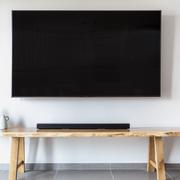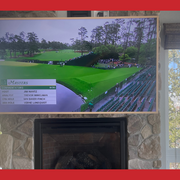What Size TV Mount Do I Need for My TV?

If you’ve ever purchased a new tv, you know the process can be a little arduous. Between trying to decide the right size tv for your space and finding the right type for your viewing habits (a Smart TV, high-def, QLED, etc.), you might search and search until you land on the absolute perfect one. Then, when you get the tv home, the technical part begins.
These days, many tvs are sleek enough to sit propped up on a piece of furniture or mount flat on the wall. But if you want to set up your tv in the best position for watching sports, movies, and more, your best bet is a MantelMount. With state-of-the-art counterbalance technology and smooth, lightweight pistons, MantelMount glides into place at eye-level for an enjoyable tv-viewing experience, and folds back up against the wall, and out of the way, when not in use.
But what wall mount fits my tv, you might ask? There are a few ways to figure out exactly what size tv mount you need for your specific tv, and this article is a great place to start! Read on to learn more about tv mount sizes and specifications and stay until the end to use MantelMount’s handy install calculator.
Things to Consider Before Purchasing a TV Mount
To find the right mount for your tv, the first place to start is with your specific tv’s VESA measurements. From there, you can consider other aspects like tilting, pull down, or articulating capabilities, as well as mounts that are able to be recessed into the wall.
VESA Patterns
If you’ve never encountered a VESA size chart, you might be asking yourself if most tv mounts are universal. The answer is yes, and no. VESA standards were first introduced in 1997 to standardize the size of display, tv, and flat-panel monitors. This allowed manufacturers to produce more units, and consumers to easily match their tv with the right mount, ultimately increasing sales.
We’ve written at length about the best way to measure and identify your tv’s specific VESA specs, so check out our guide to VESA mounting standards in order to properly measure your tv. For a quick rundown though, follow these steps:
- Measure the horizontal distance between the centers of the left and right holes
- Measure the vertical distance between the top and bottom holes
- If you’re measuring in inches, convert to millimeters (1 inch = 25.4 mm)
Here is a helpful VESA size chart for converting your tv’s VESA dimensions into their approximate inches equivalent:
|
VESA Pattern (mm) |
Approximate Inch Equivalent |
VESA Pattern (mm) |
Approximate Inch Equivalent |
|
75 x 75 |
3” x 3” |
300 x 300 |
12” x 12” |
|
100 x 100 |
4” x 4” |
400 x 400 |
16” x 16” |
|
100 x 200 |
4” x 8” |
400 x 200 |
16” x 8” |
|
200 x 200 |
8” x 8” |
600 x 400 |
24” x 16” |
|
200 x 300 |
8” x 12” |
800 x 400 |
32” x 16” |
Wall Material
Another important factor to consider, in addition to your tv’s VESA measurements, is your wall’s material. Different materials are stronger than others. For instance, it’s more likely that a brick or stonewall will be able to bear a heavier tv and, therefore, a heavier tv mount. On the other hand, a wall constructed of drywall without a stud will require mollies to hold a tv and tv mount. We’ve written extensively about different types of wall material and have answered some key installation questions on our FAQ page.
FAQ #1: Can MantelMount be installed on a stone or brick fireplace?
Further Reading:How to Mount a TV On a Brick Wall
How to Mount a TV On an Uneven Stone Wall
FAQ #2: Does MantelMount work with thin brick facades or simulated stone panels?
Further Reading:How to Mount a TV Without Studs
FAQ #3: Can MantelMount be posted to a large beam or post?
Further Reading:Where to Put a TV When There’s No Wall Space
TV Size and Weight
Of course, the most important thing to consider when choosing the right mount for your tv is your tv’s size and weight. For instance, if your tv is 44”, the VESA pattern measurements will be approximately 400 X 400mm and your tv will likely be compatible with the MM340 Mount and MM540. If your tv falls between 70” and 84”, the VESA pattern will be 600 X 400mm and your tv will match up with the MM700 Premier. However, if you're having trouble deciding, keep in mind that all of our MantelMount pulldown tv mounts work for any VESA pattern measuring between 200x200 and 600x600.
To find the perfect match for your tv, you can use MantelMount’s Install Calculator which incorporates your tv’s weight and VESA dimensions to match your equipment with the right mount.
5 Types of Wall Mounts
There are also many different types of wall mounts you may want to consider, based on the way you like to watch tv. Some tv mounts will allow you to swivel to create a better picture for seating along the edges of your room. Other tv mounts are fixed, requiring views to position themselves in front of the tv at the perfect angle and distance. Here are some different types of wall mounts to consider as you find one in the right size for your tv.
Fixed TV Mounts
A fixed tv mount is just as it sounds. The arm is stationary, positioning the tv in one spot. This is a great option for those with a living room set up that allows viewers to sit directly in front of the screen, like in a small living room. And to answer the question, are most tv mounts universal, fixed mounts are more likely to fit a wider range of tv sizes than moveable mounts.
Tilting Mounts
A tilting tv mount is a fairly simple tv mount that tilts the screen. If you have ever used a camera that is fixed to a tripod, that camera does what a tilting tv mount does: moves up and down from the fulcrum.
Although tilting a tv up so the tv is angled more towards a ceiling might not be useful — save for the instances in which there might be glare on the tv screen — tilting the tv downward can help create a better tv-viewing experience if you have to place your screen higher on the wall.
Pull-Down Mounts
Pull down tv brackets are a popular type of bracket due to their capacity of movement and can be used to adjust your tv to the optimal height. Pull down tv bracket mounts, like the MM340 Standard, MM540 Enhanced, or the MM700 Premier, for instance, have a vertical travel movement, swivel capabilities, in addition to the ability to tilt.
If you’re dealing with a tv mounted in a particularly high spot, like for instance above a fireplace, a pull-down mount can be a great solution. You just need to discover which wall mount best fits your tv before you commit to one of our state-of-the-art models.
Full-Motion Mounts
An articulating, or full-motion, tv mount is a mount that combines the three aspects of panning, tilting, and swiveling; and as all movements are able to be used with these types of tv mounts, articulating mounts can also be referred to as full motion tv mounts.
The flexibility of the range of movements in which the tv can be viewed when seated and standing are often attractive for those who own articulating tv mounts. One drawback, however, of an articulating mount is that there needs to be enough room for the movement of the mount for the user to be able to sufficiently utilize the mount to its fullest capabilities.






